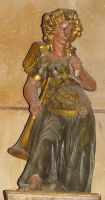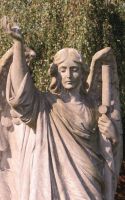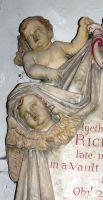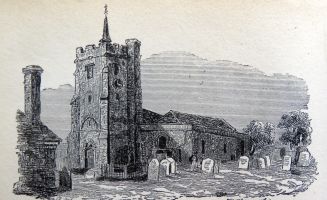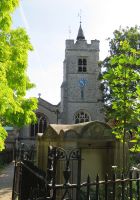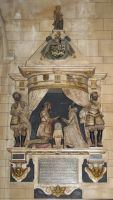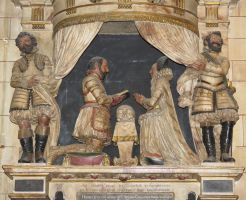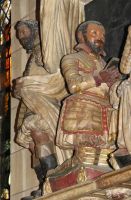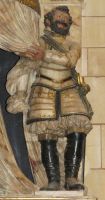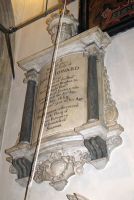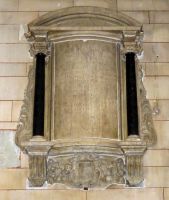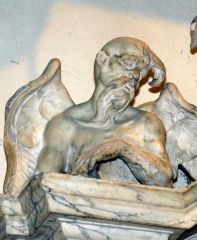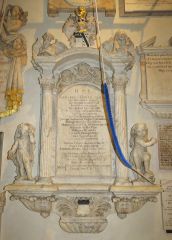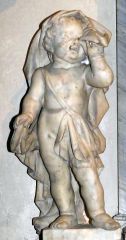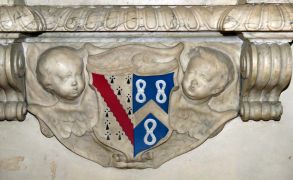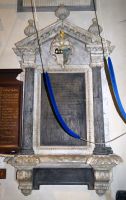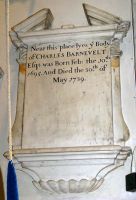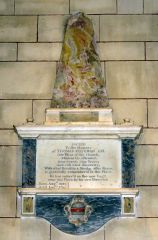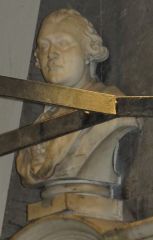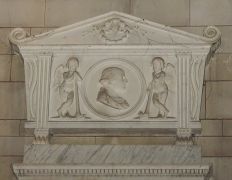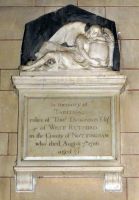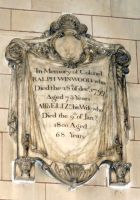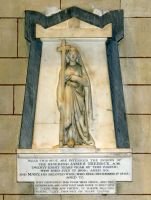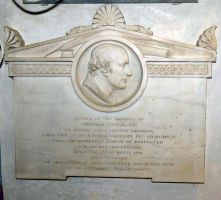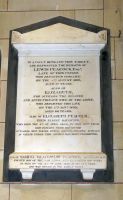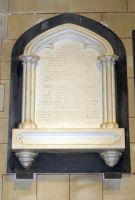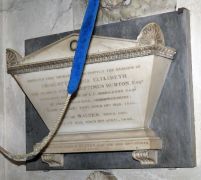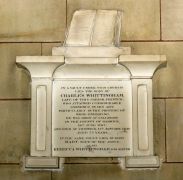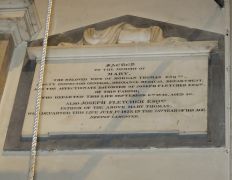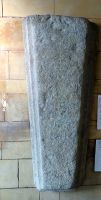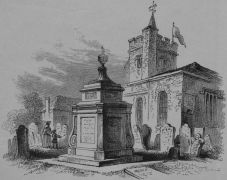Chiswick Church (St Nicholas Chiswick) - Monuments
St Nicholas, Parish Church of Chiswick, West London, contains a good collection of wall panel monuments, most notably a grand monument to Sir Thomas Chaloner, d.1615 and his two wives, and the collection is particularly strong in 18th Century panels. The painter Hogarth was buried in the extensive churchyard.
St Nicholas Chiswick, by the River Thames in ancient Middlesex, , has as its most notable feature the tower, as the body of the Church cannot be seen from any distance due to trees and buildings. This tower was erected in the early 15th Century by William a gall, the Vicar of the time, as noted in an inscription in the Church (see below); the rest of the Church was rebuilt by J. L. Pearson in 1882-1884 ‘after a somewhat imposing fashion’; the previous structure having had to have many costly repairs and a rebuild of nave and aisles in 1772, and with medievally-small windows.
Chiswick Church, then and now.
Inside, the Church feels spacious, rather of a piece due to Pearson’s efforts - he was one of the most significant Victorian church architects - with only the Chancel surviving from earlier.
Monuments
The numerous wall panels – over 30 plus a few modern brasses – are under the tower and on the walls of the nave, with some of them unfortunately skied so that they cannot be readily appreciated. They include a figure by Sir Richard Westmacott RA, portraits in relief by Sir Francis Chantrey and Thomas Scheemakers, a bust by William Tyler RA, two examples of local work, and a first-rate kneeler monument, the oldest in the Church, with which we start:
Sir Thomas Chaloner, d.1615, his first wife Elizabeth [Fletwood] Chaloner, d.1603, and second wife Judethe [Blunt], d.1615, noting his children by both wives. This earliest panel in the Church is the most ornate. It is a kneeler monument, frequently found in the late 16th and earlier 17th Centuries, thus with husband and one wife kneeling on cushions, facing each other across a prayer desk or faldstool, with other figure sculpture and ornament. Sir Thomas wears plate armour over pantaloons, and holds a book in his hands; his wife’s hands are raised in prayer. She is dressed in a garment much extended with stays (skirt supports), and has a large ruff. Skulls in such monuments as memento mori are not unusual, but not on the prayer desk, as here. The pair are under a curved canopy, with curtains drawn back by a pair of standing male figures, also bearded, with plate armour and tall boots with turned-over tops. Atop the canopy is a triangular roof, bearing the painted shield of arms, and at the very summit, a small allegorical figure of Fame. In pinkish alabaster, with paint and gilt, the ensemble is colourful and richly decorated. Further decoration include the winged cherub heads as part of the supports to the group, on either side of the inscribed panel, with a further head at the base. A note above and below the main panel says that monument was repaired at the charge of Edward Chaloner in 1721 ‘in Grateful remembrance of his Honourable Ancestor’. Splendid.
1631 tablet to William Bordall, d.1425, ‘Principal vicar of this Church of Chiswicke was Founder of ye Steeple of ye same’, noting his brass (which unfortunately has disappeared), and that Francis Lord Russell, Earl of Bedford had this stone made in 1631. Plain darkened panel with nice capitalised font.
James Howard, d.1669, nephew of James, Earl of Suffolk, ‘Errected at the Charg of Dame Elizabeth Viscountess of Shannon’. Curved panel, with free-standing pillars to the sides, Ionic and with grey marble shafts. Scroll and fruit outer embellishments, and above, a shelf bearing an ornate flaming urn with carved fruit, gadrooning and leafy base which really cannot be properly seen or appreciated. At the base, a shelf with projections to support the pillars, and grey, fluted brackets below. Between these is a lower plaque, termed an apron, bearing a cartouche of arms carved in relief, with a medley of fruits, flowers and ribbons around, exuberantly carved. A noble monument.
Later 17th Century panels with pillars: Howard and Becher.
John Becher, d.1679, his wife Magdalen, d.1680, and members of their family through to the 1690s. Hard-to-read curved panel of brownish marble, discoloured over time from white presumably. To the sides are black shafted attached Ionic pillars, and outside of these are leafy, curled side-pieces. A curved pediment sits on top without any entablature. At the base, two deep fluted brackets have between them a relief carving of a shield )with motto ‘Resurgius’, or ‘to rise again’) flanked with scrolling and many small fruits.
Richard Taylor, d.1698, his wife Ann Taylor, d.1700, and two children of their eldest son. The panel is carved as a hanging drape: such things are not common but not rare, and this one is a rich example of the type. The basic conception is standard: the inscription is on the more or less flat central, stretched portion, with elegant drop-folds to the sides and a fringe at the bottom forming a frame, and painted cartouche of arms at the top. But in this case, we have winged cherub heads supporting the drapes to the sides, and above those, further putti pop out to either side. There is a bell-shaped funereal urn on the very top. And at the base, a winged skull as a memento mori.
Richard Taylor, d.1716: grand panel of the early 18th Century.
Richard Taylor, d.1716, with Latin inscription. An early 18th Century panel, weighty and magnificent, and largest of the group under the tower. The inscribed panel is flanked by fluted pillars supporting a curved arch or broken pediment; within this are three winged cherub heads and a twisted shroud across their hair. Free standing putti are to either side of the pillars, one blotching a handkerchief to his eye, the other resting a foot upon a skull. At the top, a central painted and gilt shield of arms with surrounding mantling, and half figures on each side: one is Time, winged and heavily bearded, the other Death, a winged skeleton in a shroud. At the bottom, under a thick shelf, are a pair of floral supporting corbels, and a central apron bearing crossed branches around a small cartouche of arms, and a gadrooned (shell-like and corrugated) central terminus, which used to have a small bell-shaped lower part. Other than that, and a repainting of the coat of arms missing three little stars, it is in perfect condition. Super.
Thomas Plukenett, d.1721, and wife Grace Plukenett, d.1738, and daughter Grace Woodroffe, d.1743. The inscribed panel has Ionic pilasters with black shafts to the sides, cornice and open, curved pediment above, which once contained a thin-stemmed flaming urn. Below, a heavy gadrooned shelf, resting on curly prackets, with between, painted shield of arms between two winged cherub heads (picture above). Well-proportioned and typical of the period.
John [Joannis] Tayler, d.1729, with a long Latin inscription, referring to Margaret Delbosc, perhaps his wife, and a son, also John. Another grand early 18th Century panel. Thus the inscribed panel, in black - a hang over from the previous century - has a delicate toothed frame, and attached pillars to the sides with shafts of dark, variegated marble and Ionic capitals. These support a heavy pediment, open at the base, and within this is a cartouche of arms, painted, with knight’s helm and mantling. On the top and sides of the pediment are three gadrooned funereal urns. Underneath, a shelf with projecting sides, again heavily gadrooned like a shell, supporting curly brackets, between which is a blank, black panel. A most fine piece, typifying a favoured design.
18th Century panels: Tayler and Barnevelt.
Charles Barnevelt, d.1739, fine text on a typical simpler panel of the time. Thus there are receding side pieces, larger at the base, a broken pediment above, with the central part missing - it was a shield of arms with a painted stag – a base with mouldings, and an apron beneath with a gadrooned terminus. In flecked white marble.
Thomas Spateman, d.1761, Vicar of the Church for nearly 29 years. The earlier of a pair of obelisk monuments – the other, to Charles Holland, is noted below. Obelisk monuments started to appear in the 1720s, but reached their peak in the later 18th Century, as here. The general form is for the obelisk to be the upper of two or three sections, with a heavy shelf between to emphasise the demarcation: the inscription is generally in the portion below the obelisk, and on its own this section would form a conventional ‘fireplace like’ tablet, with side pieces and upper and lower shelves. More often than not there is a third, lower section beneath, which is the ‘apron’, though this may be quite short (lots more about obelisk monuments on this page). Opportunity for sculptural decoration is in a pot or coat or arms or (as we see below in the Holland monument) a bust in front of the obelisk; maybe some decoration on each side; or some device such as a cartouche, as here, on the apron. The use of polychromy – different coloured marbles – is frequent, giving a precious, rich and impactful monument – in the Spateman monument we have flecked white for the inscribed panel and shelves, variegated grey for the apron, yellow and black inlay for the block supports, grey and pink for the side pieces to the inscribed panel, and a glowing yellow-red-white and brown marble or alabaster for the obelisk itself. There are little protuberances to the sides of the obelisks, which once supported small flaming urns in restrained Classical style. A noble piece.
Obelisk monuments to Spateman and Holland.
Charles Holland, d.1769, with an inscription written by Garrick. An interesting monument, and a real shame it is skied in the tower and cannot be seen properly. We have an obelisk monument, with the tall, grey obelisk at the top, separated from the inscribed tablet below by a thick shelf with mouldings. Upon this shelf stands a bust of the deceased, a celebrated actor who had many affairs apparently. What we can see - and there is sort of a distant, oblique view from within the nave - is a quite self assured but heavily-jowled face, with curled hair framing a receding hairline. For the lower half, the inscription is within an oval, so the shelf above has a raised, curved centre, and this has a light, white frame and sits upon a broad slab of pinkish marble, cut with little feet to the sides. Excellent of its type. The design is by a portraitist, William Tyler RA, who had studied under Roubiliac.
Charlotte, Duchess of Somerset, d.1773, daughter to Heneage Finch, second Earl of Nottingham, and wife to Charles Seymour, Duke of Somerset. Crisply cut panel with shelf and entablature, and a very pure Classical funereal urn on top; brackets below, each with its own shelf.
Thomas Bentley, d.1780, by Thomas Scheemakers.
Thomas Bentley, d.1780, a significant pottery manufacturer and friend of Wedgwood, with whom he had a partnership. Above the inscribed panel, on a shelf, is seated a casket, with a medallion portrait of the deceased flanked by two cherubs: each leans on an upturned torch, symbol of the extinction of life. The design overall like Wedgwood pottery. The sculptor was Thomas Scheemakers, son of the better known Peter Scheemakers.
Tabitha Dickonson, d.1786, a figure piece. Thus above the framed inscription is a shelf, on which reclines an angel, resting her head and arm on a funereal urn; her other hand embraces it and holds a drape partially across it. Her figure has a nice twist, and is well draped, but only the face is classical, with the arms and hands, and especially the exposed leg, being more naturalistic and somewhat lacking in musculature. Picture below left.
Late 18th Century with carving.
Ralph Winwood, d.1799 on 28 December, and his wife, Elizabeth Winwood, d.1800, just 12 days later. Carved as a hanging drape (picture above right) – we saw one a century older in the Richard Taylor monument of 1698 noted above. Again quite complex: the drop folds to the sides, hanging from rosettes, hang downwards and inwards, giving a tapered aspect to the inscribed part; at the base is a central anthemion or palmette, with more floral brackets to each side. At the top, a cartouche, now blank, and further floral decoration.
The Hon. Thomas Walpole, d.1803, and his daughter Catherine Mary Walpole, d.1816, and added to the base, his wife Elizabeth [Vanneck], d.1760. Panel with upper lid or pediment bearing a small painted shield of arms, and thick base below. A separate panel, with upper shelf bearing a shield of arms, and little feet below, is in memory of The Hon. Margaret Walpole, but I could not read her date.
The Revd James Trebeck, d.1808, Vicar of the Parish for 28 years, and his wife Mary, d.1805. The inscription and small quote are under a shelf on which stands a nicely carved female figure carrying a tall cross [i.e. she is emblematic of Faith]. Behind her, is a conventional door-shaped panel with a sort of pediment behind, this being reflected in the outline of the shaped grey backing panel. She wears a long cape, and from her head a long veil hangs to cover one arm. This excellent piece, pictured below left, is by the illustrious Richard Westmacott – he signs ARA, for it was only in 1811 he was made full member of the Academy, and in 1837 that he was knighted, to become Sir Richard Westmacott RA.
Sculpture by Westmacott and Chantrey, Royal Academicians.
Col. John Beckwith, d.1813 or 1815, and his wife, simply called ‘Mrs Beckwith’, d.1824. Broad oval on a fluted rectangular panel, all in white, with upper shelf, on a grey marble backing.
Thomas Tomkins, d.1816, ‘whom God in his wisdom thought fit to remove from his numerous circle of respected and regretting friends’. A casket end panel in white marble, cut with feet below, lid above with acroteria, and a central roundel with a profile portrait of the deceased, high browed, head thrust forward, frowning in concentration and determination - picture above right. Above, in the shallow pediment area of the lid, we see a relief carving of quill pen and ink, and a scroll unrolling to reveal the words ‘Beauty of Writing’: Tomkins was a calligrapher and this was the title of one of his books. The sculptor was no less than the eminent Sir Francis Chantrey RA, portrait sculptor, monument maker and founder of the Chantrey Bequest.
Ann Sharpe, d.1819, a panel with a eulogy, under which is a similar panel to her son William Francis Sharpe, d. 1828, and the husband, Benjamin Sharpe, d.1838, a banker of Fleet Street, erected by his three surviving children. At the top of the two panels is a pediment, at the base, small feet.
John Forbes, d.1823, ‘a botanical collector in the service of the Horticultural Society of London, who died at Senna, on the Zambazee [Zambezi] River in Eastern Africa’, the tablet being erected by the Society. Tomb chest end in white marble, with upper pedimental lid bearing a carved flower, and thick blocky base resting on two brackets. In the chunky style.
Revd. Thomas Horne, d.1824, a tomb chest end with emphasis on the side pilasters, one of which still bears an anthemion on top; the other is missing. On a shaped black background. A panel beneath, entirely plain, is in memory of his son, also Revd. Thomas Horne, d.1847.
Mary Rachel [Walpole] Vade, d.1827, noting her relationship to Sir Robert Walpole, Prime Minister, and a son, George Ashton Vade, d.1825. Plain panel.
Peacock tablets: Classical and Gothic.
Lewis Peacock, d.1828, his wife Elizabeth Peacock, d.1839, a daughter, also Elizabeth Peacock, d.1865, and on the base, Lieut. Samuel Blackshaw Peacock, d.1826. Another blocky monument, this time in a vertical format (picture above left). Hence a tall inscribed panel, a thick pediment with acroteria, a thick lower shelf and moulded brackets. On a shaped black backing panel and signed by the maker, T. Dorey, Strand on the Green, Chiswick’ who is obscure - the only other piece I have seen by him is a humble tablet to Elizabeth James, d.1847, in St Mary’s Ealing. There is a second tablet next to it (picture above right), also to a Lewis Peacock, Elizabeth Peacock, and Anne Peacock, but rather faded and I could not read the dates. It is a white-on-black tablet, but a Gothic one, with clustered pillars to the sides, and a tripartite pointed arch, and below the lower shelf, attached polygonal supports, all on a black shaped backing, signed by Thomas Gaffin of Regent Street, most prolific of all statuaries for this type.
Augustus E Brande, d.1834, with added inscriptions to others of the Brande family, through to 1869. Witha damaged pediment above a shelf, and a blocky base supported on brackets.
John Sich, d.1836, his wife Anne Sich, d.1824, and daughter Harriot Sich, d.1830. White panel cut as a simple tomb chest end with upper shelf, lower feet, and a shaped black backing with a curvy lower edge to allow for a shield of arms, presumably once painted. By it is a second panel, to John Sich, d.1855, his son John Sich, d.1853 at New Orleans, another son, Thomas Sich, d.1855, Elizabeth Sich, wife of John Sich, d.1860, and their youngest son George Sich, d.1863. Another simple tomb chest end, with no insignia.
Simon Cock, d.1837, with a eulogy, erected by a few of his friends. All of white marble, in the chunky style, with receding sides, cut with a solid pediment, an even solider base, and supports. The only carving, which is good, is a group of flowers – lily, rose perhaps and some smaller florality – in the pediment. Signed by Ternouth of Pimlico, who seems to have been a better figure sculptor than monument maker.
Charlotte Lydia Elizabeth [Middleton] Burton, d.1840, and her infant son Walter, d.1840, a month after his mother. And added to the base, the husband, Septimus Burton, d. 1842. A fine casket end monument. We see the long side of the casket with the inscription, a lid above a rim bearing repeating patterns, a tiny snake swallowing its tail above, and fine acroteria (‘ears’) to the sides. The casket, with its sharply angled sides, rests on a base with mouldings, supported on two feet or brackets. The casket is not flat against the baking at all, but sticks out a good way at the top, as can be seen from this side view. I could not read the faint signature of the mason.
1840s panels: Burton, Whittingham, Thomas.
Charles Whittingham, d.1840, and his wife Mary, and sister Rebecca Whittingham, both undated. Interesting in that Whittingham was a printer, who the panel writes ‘..attained considerable eminence in his art, particularly in the printing of wood engraving’. Idiosyncratic in that the side pilasters and their upper capitals are oversized; appropriately for his occupation as a printer specialising in cheap books and more expensive woodcut printing, at the top is a carving of an open book.
Mary [Fletcher] Thomas, d.1846, and her father Joseph Fletcher, d.1853. Cut as a tomb chest end with upper lip and a broad, draped Aladdin’s lamp style draped pot on top. On a black backing, dimly signed by the carver, who might be C or G. Row, of Chiswick – the tablet was too high up to be sure.
The Revd. Thomas Frere Bowerbank, d.1856, Vicar of the Parish for 40 years, and his wife Catherine Jane, d.1859, erected by the daughter, E.M. Bayley. Plain black panel with a central cross in white marble.
Young family, 1883. Miss Dorothy Young, d.1776, her father Robert Young, d.1791, and his husband Mrs Dorothy Young, d.1806, with a note that the stone bearing this inscription was removed from the south aisle on the rebuilding of the church in 1883. Plain white streaky panel on two block supports.
Plain panel recording that the tower was made good in 1936, 500 years after the death of its builder, Revd William Bordell, and in memory of Frederick Walter Isaacs, Vicar of Chiswick to 1919.
Cattell panel, 1974, noting that the clock and bell in the tower were repaired and electrified etc, in memory of Bertha Agnes Cattell, d.1949, and Flora Betty Cattell, d.1972, successive wives of an officer in the Middx. Regiment. A 1979 panel to the Regiment and to Major Bernard Kingston Cattell, d.1978 is nearby.
- There are a few other simple panels, variations on the tomb chest end, not noted here, and apparently several other sustantial 18th Century panels which I did not see on my visit to the Church.
There are a small number of simple modern bronze panels, and other very recent plaques, without carving or decorative interest. And an ancient, plain inscription to Mary Litcott, d.1599.
Also in the Church:
Also of note are:
An ancient stone coffin mounted on the wall;
The font, a great squat thing, eight-sided, Victorian in Norman style, with four vignettes with Biblical scenes.
Good Victorian encaustic tiles in the Chancel area.
Victorian reredos, Gothic triptych with Crucifixion etc and four standing saints.
Middlesex Regiment WW1 monument, a brass panel with the Regimental coat of arms and pilasters to the sides; there is also a stone panel.
Several 19th and 20th Century commemorative brass plaques.
A window of 17th or 18th C Flemish design.
Churchyard:
The extended and extensive churchyard houses the tombs of William Hogarth among others; see this page.
Hogarth's tomb in Chiswick Church yard.
The St Nicholas Chiswick website is at https://www.stnicholaschiswick.org/heritage/history/.
Go North to Acton Church or North West to Ealing Church or East to Fulham Church, or across the river, South West to Mortlake Church and Richmond Church, or more West to Kew Church
Sir Thomas Chaloner, d.1615.

